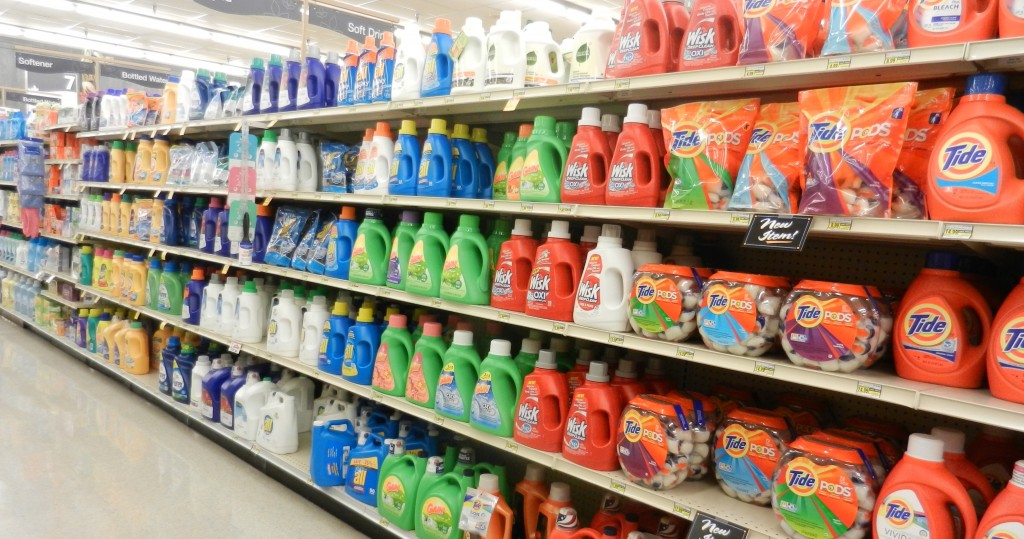
Does the smell of bleach make you think that your clothes are “clean”? Do you like that flowery scent? I used to love that the warm, fluffy, soft feeling after the clothes were pulled out of the dryer. A while ago I read about bleach, detergents and fabric softeners – laundering my clothes became a totally new ball game!
Detergents and softeners leave dangerous chemical residues on our clothes and skin, and toxic fumes in the air that we breathe. Fortunately, changing our cleaning products is one of the simple changes that we can make.
Over 600 laundry products, from 95 brands, were evaluated – a whopping 80% of them received D’s and F’s. What’s worse is that these 80% are the most commonly used products; the ones most grabbed at the grocery stores and marketed on commercials. Some of them even state “dye free”, “fragrance fee”, “baby” or “natural” on their labels…. it certainly gives one an impression that they are not harmful. Good marketing, good sales! And further in the post you can check to see how your detergent rates on a scale of A to F.
Now, the use of synthetic powdered or liquid laundry detergent is used. The conversion of aviation fuel plants were used to produce tetrapropylene, which is used in many detergents. What’s disturbing about cleaners in general is that companies are NOT required to disclose all the ingredients on the label. And, you can be sure that they don’t always list them! They would certainly have fewer purchases if they listed all the nasty ingredients for everyone to take notice of.
What’s Wrong With the Laundry Products?
Bleach
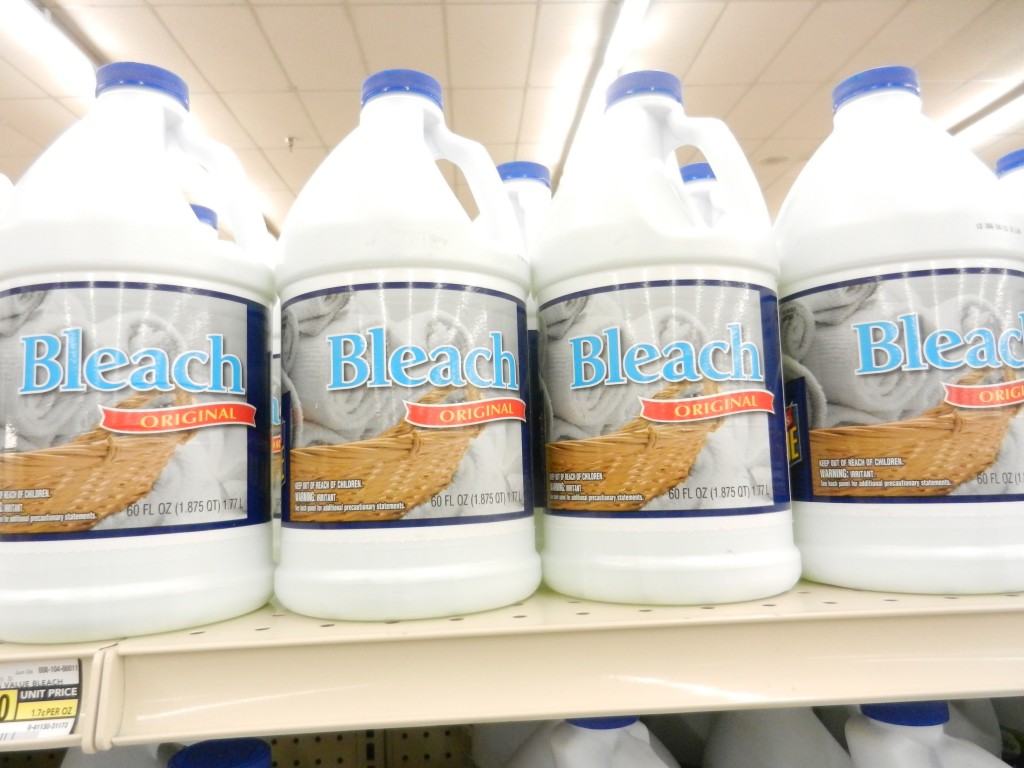
Chlorine Bleach and Chlorine-free/bleach alternatives. Both kinds of bleach are harmful in that they are corrosive and irritating, but “chlorine bleach” releases harmful chlorine gas and users have a higher risk of developing asthma and other respiratory problems. In addition it breaks down the material of the clothes faster. Products labeled “chlorine-free” do not contain chlorine bleach, but may contain oxygen bleach instead. The Environmental Working Group (EWG) recommends avoiding chlorine bleach and using chlorine-free alternative when necessary. Yet, there are other alternatives than “bleach”.
Detergents
Some of the major brands of detergent contain formaldehyde (formalin) which is classified as a known human carcinogen by the U.S. government and World Health Organization. Formaldehyde can cause asthma and allergies. In addition, most detergents have petroleum-based chemicals in them. Optical brighteners, that makes fabrics appear brighter, is basically a coating that sticks to fabric even after rinsing and can cause skin irritation.
Here are just a few of the brands that have familiar labels or what seem as “safe” wording in their names that were rated “F” in the comprehensive evaluation by the EWG:
- Gain Liquid Detergent with Baking Soda, Fresh Water Sparkle
- Era 2x Ultra Liquid Detergent with Oxi Booster
- The Laundress Baby Detergent, Baby
- Green Works naturally derived laundry detergent, original
- All 2X Ultra Stainlifter Concentrated Liquid Laundry Detergent
Fabric Softeners – liquids for the washing machine or sheets for the dryer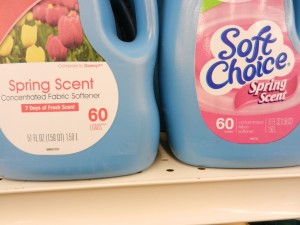
Dryer sheet and anti-static sprays are great for static, but they have chemicals in them that cause central nervous system disorders, irritate lungs, cause (note, not “aggravate”, actually “cause”) asthma and skin reactions and that are carcinogenic (in relation to pancreatic cancer). I couldn’t even attempt to list all the chemicals that were listed in fabric softeners – this post would be sooo much longer! Here are just a few that were graded “F”:
- Kirkland Signature Fabric Softener Sheets
- Downy Ultra Fabric Softener, Sun Blossom
- Nellie’s Dryerball All Natural Fragrance Sticks, Lavender
Another study, from the University of Washington found that chemicals in the most popular brands of scented liquid laundry detergent and scented dryer sheet contains hazardous chemicals. The scent and product are not washed off of the clothes when they are run through the washer or dryer (as you know because the clothes are still scented and feel smoother). The emissions that come out of the vent when using the dryer having used scented dryer sheets and/or scented detergent had gases made up of over 25 volatile organic compounds, including seven hazardous air pollutants, and two that are classified as carcinogens. Emissions from vents are essentially unregulated and unmonitored.
The drained water from the washer using fabric softener now contains these chemicals and the emissions that came out of the dryer are toxic. When I had my dryer running, my daughter and I would sometimes be outside playing and the scent of the dryer coming out of the vent nearby was somehow comforting…. that changed!
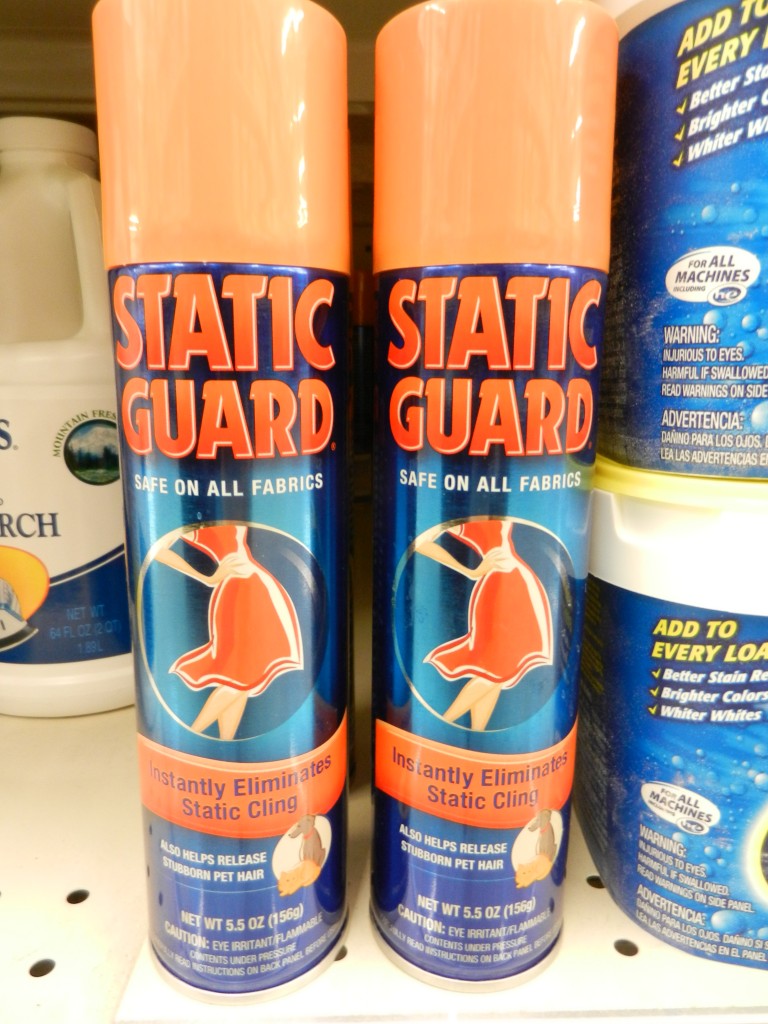 And, after the dryer… Static Guard, which the European Union banned! Just smelling it can give you an idea of what is in there. It’s one of the worst.
And, after the dryer… Static Guard, which the European Union banned! Just smelling it can give you an idea of what is in there. It’s one of the worst.
Drycleaning
The dry cleaning solvent that is typically used is tetrachloroethylene (perchloroethylene), which is also called “perc”. The International Agency for Research on Cancer classified tetrachloroethene as a Group 2A carcinogen, which means that it is probably carcinogenic to humans and soil contaminant. It is also a central nervous system depressant and can enter the body by breathing it in or through ones skin, and can cause skin irritation.
I don’t have a solution for dry cleaning; I know there are Non-Toxic drycleaners out there. Honestly I haven’t been to a dry cleaner for ages. Check local drycleaners that state that they are eco-friendly or non-toxic and confirm that they do not use a petrochemical solvent and check to see what they do use.
Who rated them?
The Environmental Working Group is non-profit, American environmental organization that specializes in research and advocacy in many areas related to public health and environment. They rate categories of products on a yearly basis. Their Cleaning Products analysis was based on numerous factors, such as ingredients, type of chemicals used, chemical toxicity levels for humans, labeling, and environmental toxins. For a detailed look at their methodology, click here.
The Environmental Working Group recommends that consumers:
- Support state and federal efforts to require cleaning product companies to disclose all ingredients on the label, where consumers need this information most;
- Support reform of the outdated and inadequate federal system for protecting people from toxic chemicals;
- Buy safer products with the help of the EWG’s Guide to Healthy Cleaning, and try safer homemade recipes using kitchen ingredients;
- Press schools, daycare centers and workplaces to clean with safer, certified-green products.
How Can I Find What My Products are Rated?
You can type in your product in their Search engine and see where your detergent was ranked on the Environmental Working Groups analysis of over 2000 Cleaning Products (most of which were under the Laundry category). Go to their link by clicking here.
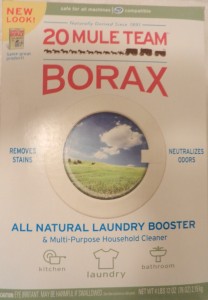

What Products Can I Use Then?
You can view alternative laundry products that have A & B ratings at the EWG site here. Most of these can be purchased at your local health store, some grocery stores, and online at Amazon, drugstore.com, Alice.com (online shopping is how I like to make most of my shopping simple).
Here are a few that were rated “A” by the EWG:
Detergents
- Arm & Hammer Super Washing Soda Detergent Booster & Household Cleaner
- Dr. Bronner’s 18-in-1 Hemp Pure-Castile Soap Baby Mild
- Planet Ultra Powdered Laundry Detergent, Hypo-Allergenic
- Seventh Generation Natural Powder Laundry Detergent, Real Citrus & Wild Lavender
- Whole Foods 365 Everyday Value 2X Concentrated Laundry Detergent, Unscented
Bleach
- Earth Friendly Products OXO Brite Non-chlorine Bleach
- Ecover Non-Chlorine Bleach Liquid
- GrabGreen Bleach Alternative
- Seventh Generation Chlorine Free Bleach, Free & Clear
Stain Removers
- OxiClean Laundry Baby Stain Soaker
- Rit Laundry Treatment Color Remover
Softeners
- Green Shield Organic Fabric Softener, Lavender Mint.
Other Alternatives for Detergents, Bleach and Softeners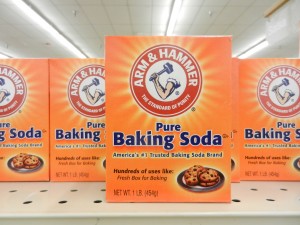
Very basic cleaning products such as baking soda, washing soda, borax, vinegar, peroxide or soap flakes are great… and you could make your own special mix. It’s easy and inexpensive and you only need a few products.
For detergent
- Take a look at this simple recipe for DIY Laundry Detergent.– it’s eco-friendly and toxin-free made out of soap flakes, borax and washing soda. You can also add to it what you prefer. There are some other helpful laundry tips with other common ingredients you have around the house in that post.
For stains or whitening
- Use hydrogen peroxide. You can soak a garment overnight with a cup of hydrogen peroxide mixed with a ½ gallon of water in a small bucket. For little spots, give it a try, it’s not as harmful to the clothes as bleach is either. Then wash clothes as you normally would with detergent.
- Another option is using white vinegar (1/4 cup or so) to the cold water in the washer before adding the detergent and clothes. It helps to remove stains, remove odors, brighten colors, helps colors to not run and softens fabric.
- And, for those small stains, make a paste out of baking soda and water. Put it on the stain and let it set, and then wash as normal.
For static or fabric softener
- Use baking soda in the rinse cycle of your wash to soften clothes. Baking soda is also good for removing odors.
- Or, add Vinegar to the rinse cycle to prevent static cling.
- Personally I use dryerballs and do not bother with static sheets or softeners.
Dryerballs help to dry the clothes evenly and without scents or residue. Drying for too long creates more static. I got mine from Norwex (and disclosure here… I am an Independent consultant with Norwex – because I love their products!), but you can get dryerballs at Amazon, drugstore.com, or other physical locations as well. Always use them in pairs.
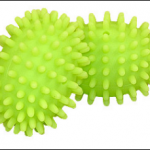
Helpful hint – do not over dry you clothes, whatever method you chose. Over drying causes static build up…. my mom still likes to hang the clothes outside.
In Summary
For those who are eco-friendly, health conscious or especially if you have allergies, asthma or chemical sensitivities I urge you to evaluate your laundry detergents. Look for products that are not full of phosphates, petroleum solvents, chlorine, perfumes, dyes, animal byproducts, and other toxic compounds or simply make your own – it’s generally cheaper and a really easy DIY recipe. You can find the recipe for laundry detergent by clicking here. It’s easy to switch products, and create a change that benefits us every single day. Those nicely scented, fluffy clothes may present different thoughts now.
If you thought this post was helpful, subscribe to receive future posts on informative topics sent directly to your Email. For FREE blog Updates, Subscribe by clicking here.
Comments? Make a comment below? Where was your detergent rated? Was this helpful at all?
Please subscribe to get future posts on subjects that may interest you by clicking here and also share this site with your friends by using the social media icons directly below or on the right side of the page.
This post is shared at: thank your body thursday, fight back fridays, small footprint friday.
sources:
immuneweb.org
washington.edu hazardous-chemicals-through-dryer-vents
wikipedia.org,
ehow.com- use vinegar,
ehow.com- use baking soda,
photo credit: judy@LHNH, Norwex
disclosure: cmp.ly/4 and cmp.ly/5
Disclosure: Please know that if you make a purchase using a link on this post or site, I may earn a small commission. Some of the links are affiliate links, and when you click them you allow me to cover a small portion of the cost of this blog. I am very grateful for your support of this site - Thank You! You can read all the fine print here
-
Lisa, Thanks you so much for your comment! I describe the benefits of vinegar and some other common ingredients that are useful for laundry in the DIY Laundry Detergent recipe. I probably should have written about them in this post in more detail. I appreciate you sharing your experience with DIY detergent and vinegar… and please let us know what you think of the dryer balls after using them.
March 14, 2013 — 11:39
THANK YOU for such an informative article! I’m shocked. I’ve been buying “environmentally friendly” detergents from either Costco or Trader Joe’s, and everything I’ve bought was rated either D or F. I am particularly bummed about Trader Joe’s dish washing detergent…I thought I’d finally found a natural detergent that actually works! Back to the drawing board, as they say. : )
-
Thanks so much for you comment. The labels and marketing definetly build our confidence. I hope you spotted some on the A & B list that are readily available to you at a local store, if not, some of the online resources have a huge selection and decent prices.
March 7, 2013 — 16:31




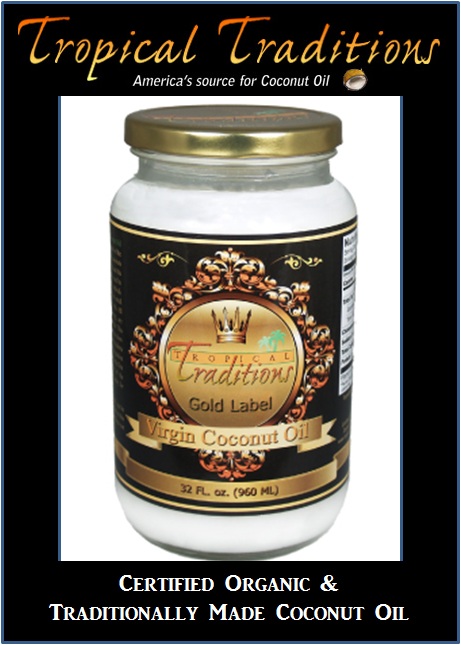

Hello, I have been using DIY laundry detergent since my son was born. I use cloth diapers as well. The vinegar removes the odor and hanging out to dry in the sun magically removes all stains. I have just now purchased the dryer balls. Thank you for your information.